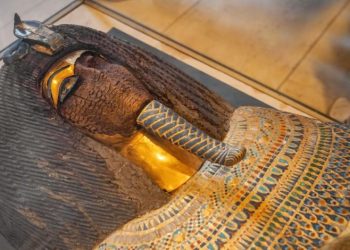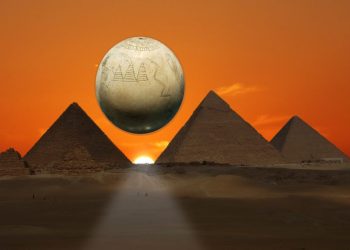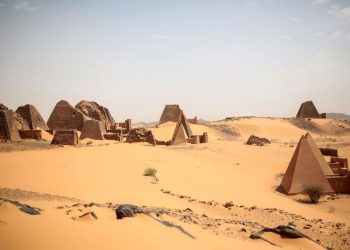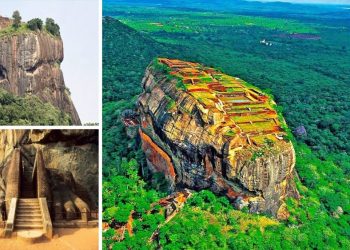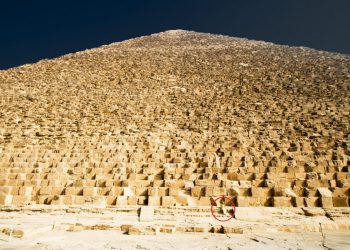None of the pyramids worldwide are as famous as the majestic ancient Egyptian pyramids. There are around 120 pyramids in Egypt, depending on what sources are consulted. Although many pyramids remain standing today—despite having been built around 4,700 years ago—many others are no more than rubble, unrecognizable, and far from their former glory. Egypt’s oldest pyramid, the Step pyramid at Saqqara, is acknowledged as the first pyramid in Egypt. The mainstream chronology of ancient Egypt dictates that this pyramid was built during the Third Dynasty and commissioned by king Djoser. This was around 4,700 years ago, give or take a few years. Before Djoser and during the First and Second Dynasties of Egypt, monuments were built mostly out of wood, mud bricks, and reed. In a sense, these were lesser structures.
Never before seen
When Imhotep designed Djoser’s pyramid, he envisioned what no one before him had: A massive pyramid complex whose central structure was a monument that Egypt had never before seen. Not only that, but Imhotep also wanted this unique structure to stand the test of time, and there was only one way to make sure that this would be the case; build the monument of larger and longer-lasting materials. To obtain these materials, he didn’t have to look far, for Saqqara is surrounded by vast limestone deposits.
Tombs
The step pyramid is seen as a direct evolution of the mastaba tomb. Djoser’s monument is thought to have been deeply influenced by mastabas built previously at Saqqara. Therefore, Egyptologists believe that the first Egyptian pyramid, and all other pyramids that followed, were tombs for the Kings (and eventually queens) of Egypt. Eventually, the Step Pyramid changed Egyptian architecture and kick-started a long period during which some of the most amazing pyramids on Earth were built. A few generations after Djoser and Fourth Dynasty, Pharaoh Sneferu would once again change the Egyptian pyramids by fundamentally redesigning the Step Pyramid introduced by Djoser.
Three gigantic pyramids
Sneferu is thought to have commissioned three gigantic pyramids; one was built at Meidum, essentially a step pyramid, and two others at the Royal Necropolis of Dahshur. The pyramids of Dahshur deeply impacted Egyptian pyramid-building techniques and laid the foundations for the greatest pyramids of Egypt, which were built during the Fourth Dynasty: Khufu’s Great Pyramid and Khafre’s majestic structure. Sneferu is seen as the greatest pyramid builder in Egyptian history, having built not one but three massive pyramids. Although many people don’t know this, Sneferu built the third-largest pyramid in Egypt after the pyramids of Khufu and Khafre.
Three Generations
In that sense, we can say that Egypt’s most massive pyramids were built across three generations: Sneferu, his son Khufu and his grandson Khafre. Egyptologists unanimously agree that these supermassive monuments had no purpose other than safeguarding the Pharaoh’s mummy in the afterlife. Despite this, we know of pyramids—Egypt’s provincial pyramids—which were clearly not tombs, as experts have not found any traces of chambers or sarcophagi inside them. These are thought to have been built not as tombs but as monuments that primarily showcased the power and might of the Pharaoh. But Egypt isn’t the country with the most pyramids on Earth. In fact, it isn’t even the country with the oldest pyramids.
The Pyramids as temples
Halfway around the world, in present-day Brazil, an ancient culture—now lost to history—erected what experts believe are the oldest pyramids on Earth. It is thought that around 3,000 BC, well-developed societies constructed towering pyramids, some of which covered more than 30 acres. Experts believe that more than one thousand pyramids were built in Brazil, but no more than a few dozens remain today. But the Brazilian pyramids were unlike those in Egypt. The greatest difference is perhaps the construction material used to build the pyramids. While the Egyptians used materials such as limestone and granite, the Brazilian pyramids built their pyramids mostly out of seashells. Furthermore, while the Egyptian pyramids are known for their internal chambers, the Brazilian pyramids were void of such.
Similar but different
This also tells us that the two pyramids, although erected in similar designs (same four sides, built upwards, etc.), served entirely different purposes. The Egyptian pyramids are said to have been the tombs of the Pharaohs, but the Brazilian pyramids likely served a different purpose and were used as temples rather than tombs. They might also have been used as gathering places or locations where the ruling elite would address people at particular times, during rituals, or even sacrifices.
Brazilian Pyramids destroyed
Although many Brazilian pyramids are entirely destroyed, many of which were mistaken as mounds of rubbish in the 19th and 20th centuries, those that have survived reveal a 5,000-year-old secret: the builders of the pyramids erected another structure on top of the pyramids. This means the builders would construct another structure atop the pyramid when the pyramid’s core was mostly finished. This similar fashion would later be adopted in the Central and North American pyramids. Therefore, unlike the Egyptian pyramids, the Brazilian pyramids may have served as temples where rituals were performed or where the ruling elite would gather at important events.
Pyramids in present-day Peru, probably around 5,000 years old, can also be regarded as temples since no evidence points towards the pyramids being tombs either.
Sacrificial centers
In Central and North America, civilizations such as the Aztecs, Maya, Olmecs, and other perhaps far ancient cultures erected pyramids. The most famous pyramids in North America were built in Mexico. The largest pyramid on Earth, even larger than the Great Pyramid of Giza, stands in present-day Puebla, not far from Mexico City. Another ancient city, Teotihuacan—the place where gods were born—is home to three distinct pyramids, some of which are among the best examples of pyramids in Mesoamerica. Mexico is home to pyramids ranging in different sizes. Many Mexican pyramids—like those built by the ancient Maya civilization—resemble pyramids built halfway across the world in places like Cambodia.
North and Central American pyramids
So, what were the North and Central American pyramids? Were they tombs like the pyramids of Egypt? Or were they mere temples, like the pyramids of South America? The answer is debatable, but I would say that the pyramids found across Central and North America served different purposes depending on their location. Some pyramids, like El Castillo at Chichen Itza, are often referred to as temples and may have been more than just that. The pyramid has chambers, just like many Egyptian pyramids, but their purpose was different.
Inside El Castillo, researchers found evidence of offerings inside the pyramid, which indicates it was deeply connected to sacrifices. One room inside the El Castillo pyramid was dubbed the Chamber of Sacrifices. In a sense, pyramids like El Castillo were both sacrificial pyramids and pyramid temples around which people would gather on important occasions, many of which were most likely sacrifices, which played a crucial role in societies such as the Maya.
Have something to add? Visit Curiosmos on Facebook. Join the discussion in our mobile Telegram group. Also, follow us on Google News.







